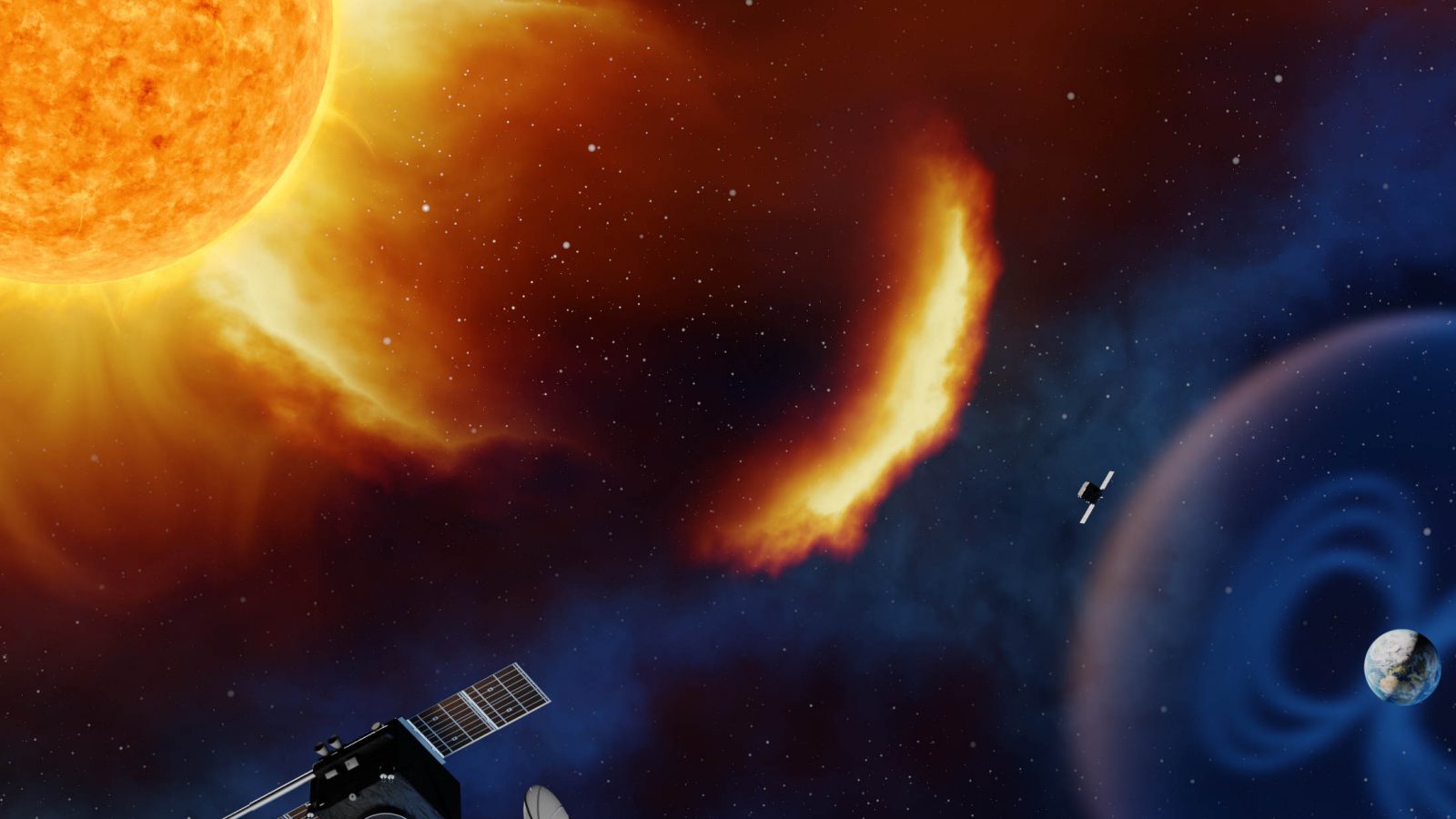
Space Weather – How the sun threatens critical infrastructure
Picture: ESA/A. Baker,CC BY-SA 3.0 IGO, changes madeIn June 2012, the world narrowly escaped a catastrophe. On a global scale, communication systems would have been damaged, possibly resulting in blackouts, disruptions to supply chains and break-down of basic services. The warning time would have been a few hours at most, the recovery could have taken years and could have cost up to trillions of dollars. What sounds like a terrible hacker attack or act of sabotage would have had a natural cause: one of the largest solar storms ever recorded, which missed the Earth only by a small margin.
What is space weather?
Our solar system can be a rough place. The sun is continuously emiting a wide variety of high-energy radiation. Usually, we are protected from this radiation by the earth’s magnetic field and our atmosphere. However, extreme solar activities such as solar flares and coronal mass ejections can severely disturb our daily life. When the radiation penetrates our shielding atmosphere, high electro-magnetic fields can directly damage electrical infrastructure such as telecommunication, power grids and transport networks. Satellite infrastructure is even more vulnerable. The result of extreme solar activities can range from economical losses to supply shortages up to a global scale. Since society relies more and more on sophisticated technology, its vulnerability to the so-called space weather increased.
Influence on the finance sector
In the finance industry, for example, the space weather can impact precise time measurements. For all financial transactions, trading and risk management, precise time stamps are needed. Normally, accurate timing is provided by the Global Navigation Satellite System. In case of an extreme space weather event, satellite systems are not reliable anymore. Then, emergency systems need to maintain timing such as land-based connections to atomic clocks (e.g. provided by the national metrology institutes) or the usage of holdover oscillators. If such alternative technologies are not available or used, financial transactions and trading need to complety halt for the time being. A historic example is the March 1989 geomagnetic storm where Toronto‘s stock exchange had to stop any activities due to a solar storm.
Fig. 1: Current forecasts of near-Earth solar wind from the ESA Space Weather Service Network, © ESA
Risks in interconnected infrastructure
The financial system is just one part of our complex modern-day society. Understanding the influence of space weather events on single components such as satellites is rather straight-forward. However, due to the high interconnection of technology, damages can cascade through different layers of infrastructure. So far, these interactions are not fully understood. The timing loss in financial systems can affect the electricity market and thus, the power grid which effects almost all industries and supply chains. Therefore, critical services can even be indirectly vulnerable due to their dependencies on other infrastructures.
Mitigation
Possible mitigation strategies include building early-warning systems and decreasing dependencies from other infrastructure. The weather forecasting and national risk-assessment programmes in the US and some European countries already consider the impact of space weather. National institutions such as the UK Met Office offer alert systems and technical guidance while both NASA and ESA operate space weather services. Nonetheless, forecasting precision and warning times are still limited. Thus, both governments and businesses need to further strengthen their resilience to extreme space weather events and coordinate their actions on an international level. Close cooperation between regulatory bodies, industry and research is key for gaining sufficient data and developing suitable solutions for the whole society. In the last years, significant efforts have been made to protect critical infrastructure but even today, geomagnetic storms can cause significant damages.
Literature
J. Wattles (2022): SpaceX will lose up to 40 satellites it just launched due to a solar storm. CNN Business
E. Krausmann et al. (2014): Space Weather and Financial Systems: Findings and Outlook. JRC Science and Policy Reports
T. Phillips (2014): Near Miss: The Solar Superstorm of July 2012. NASA Science
R. Sanders (2014): Fierce solar magnetic storm barely missed Earth in 2012. Berkley News
C. M. Ngwira et al. (2013): Simulation of the 23 July 2012 extreme space weather event: What if this extremely rare CME was Earth directed? Space Weather Vol. 11 Issue 12
D. N. Baker et al. (2012): A major solar eruptive event in July 2012: Defining extreme space weather scenarios. Space Weather Vol. 10 Issue 11
L. Dayton (1989): Solar storms halt stock market as computers crash. New Scientist

